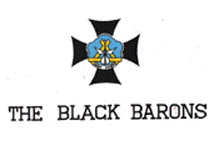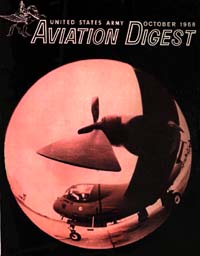 |
Black Barons 269th Combat Aviation Battalion |
 |
Black Barons 269th Combat Aviation Battalion |
| Article Index | Table of Contents |
 |
...above all things, the
Black Barons seek to
be a lasting tribute to the spirit of Army aviation
Captain Matthew R. Kambrod
 |
 |
A WEATHER SHIP searches the skies of Vietnam at 0400 hours. Artillery rounds flash sporadically in shadowed rice fields far below while a dark mass slowly gathers, billows, and soon looms eerily over the landing zone. In an operations bunker northwest of Saigon, an air mission commander receives reports from the airborne weather crew before committing his airmobile assets to a long day of war. Within minutes he boards a command and control aircraft carrying an air mobile task force commander and proceeds aloft to guide the conduct of the assault. In a base camp pickup zone- not far away, 60 crews ignite the turbines of their helicopters. Darkness still shrouds the aircraft as ground troops, mounting the waiting lift ships, lean against the bulkheads, nervously hoping for a final rest before reaching the landing zone. The slick ships rise slowly in sequence and tilt forward, their rotors straining to lift the heavy loads over the thick canopy of trees which now too rapidly approaches the dimly lit cockpits. Some apprehension, a hopeful pull for more power, a tightness in each pilot's stomach as his skids brush through the treetops, and then relief as the flight lifts and all ships are reported airborne Another day thus begins for the 269th Combat Aviation Battalion Vietnam's Black Baron Battalion. Activated for deployment to Vietnam at Fort Bragg NC in July 1966, the 269th arrived in the Republic of Vietnam in January 1963. Designated as the primary aviation support battalion to the 25th Infantry Division, the 269th consistently has been committed to the execution of airmobile operations in major exercises conducted in the III Corps tactical zone. This included airmobile insertions of U, S. Forces into the landing zones of Junction City TI, Kole Kole, Diamondhead, Barking Sands, Manhattan, Atlanta, Yellowstone, and innumerable other significant operations. Heavily committed in the terrain of war zone C, the Parrot's Beak, the Iron Triangle, and Hobo Woods, the 269th has earned many distinctions The employment of Black Baron aircraft in these hotly contested areas, however, has taken its toll. Considerable damage from hostile fire was inflicted on 269th ships in a span of six months, but most of the aircraft were either able to return under their own power or were recovered by CH-47s. Battalion headquarters for the 269th is located at Cu Chi, 30 miles northwest of Saigon. This also is the base camp of the 25th Tropic Lightning Division. In fulfilling its tactical missions the 269th has six subordinate units: a headquarters company, three assault helicopter companies, one assault support helicopter company, and one reconnaissance airplane company. The assault helicopter company base camps, strategically located to afford the best tactical support to each of the three brigades of the 25th Infantry Division, span the entire western breadth of the III Corps area. The airmobile companies are better known in their tactical environments as the Hornets (116th), the Black Hawks (187th), and the Black Widows (188th). Each is basically comprised of troop carrier helicopters and gunships, both of which are models of the famous Bell Uh-I. All the aircraft are armed for protection. The gunships, however, as primarily offensive machines, are heavily laden with varied ordnance systems. Included in the arsenal are 20 mm and 40 mm guns, 2.75" and 3.5" racket launching systems, and 7.62 mm mini guns. Each assault company has on numerous occasions been subjected to some of the heaviest fire Charlie could deliver. This includes automatic weapons, RPGs, and mortars. The Black Baron CH-47 unit, known as the Muleskinners, is the 242d Assault Support Helicopter Company. Flying from Cu Chi, the crews of these medium cargo helicopters re-supply forward field positions with rations, heavy weapons and other forms of logistical requirements. The huge Chinooks also have inserted and extracted troop units. The true value and capability of the CH-47 greatly expands the resources of the Black Barons. The Battalions fixed wing unit, the 21st Reconnaissance Airplane Company, the Black Aces, located at Tay Ninh, provides a visual reconnaissance capability to the many units in the III Corps area. Day and night the low drone of an 0-1 can be heard above as pilots and observers methodically search the ground for the elusive enemy. The capability of these crews to call for and control artillery barrages makes the Bird Dog one of the most formidable and deadly weapons in Vietnam. The 269th also has its own specially modified smoke ship, "'Smokey Baron." This aircraft Is used extensively on all airmobile operations, be they battalion or company size. Daily, Smokey can be seen shuttling from one operational area to another in support of the battalions aviation elements. Upon request from infantry ground commanders, smoke screens have been laid to support an infantry ground move or to assist an urgent medevac. Denying the enemy a point target, the smoke ship has substantially decreased the number of aircraft losses normally assessed as damage from enemy fire. In fact, as of this writing, no aircraft has been shot down in a landing zone which was smoked by Smokey Baron. The aviation battalion has an organic pathfinder detachment, the Cavaliers, assigned to it. This unit provides navigational assistance and terminal guidance to all of the battalions aviation elements. Primarily, however, pathfinder personnel have been used in the control of infantry elements in pickup and landing zones. Normally inserted into forward field locations hours before an airmobile operation, pathfinders have been responsible for ensuring the correct placement of loads in suitable locations (*Since this article was written the 21st and 188th have been transferred from the battalion.) for an airmobile pickup. They have also been heavily committed to the control of logistical moves by Chinooks. The successes achieved by the 269th in the conduct of airmobile operations has in no small measure been due to the efficiency of its pathfinder personnel. The Black Barons conducted their first combat assault on 14 April 1967. Today the unit has participated in 46 battalion-sized and hundreds of company-sized combat assaults. Its operations have supported not only the U. S. 25th Infantry Division, but also the U. S. 1st and 9th Infantry Divisions, the 199th Light Infantry Brigade, the 5th U. S. Special Forces Group, the 1st Australian Task Force, and the Tiger and White Horse Divisions of the Republic of Korea Army. Black Baron airmobile operations have required the frequent attachment of complete aviation battalions, placing over 100 aircraft in the air at one time in the conduct of a combat assault. In fact, on the 42nd battalion operation more than 100 UH-1s and 30 CH-47s and CH-54s were used in what was probably the largest airmobile assault ever conducted. While individuals may readily be identified for their achievements, the full success of the battalion, however, must be attributed to the men who form It and have fought and continue to fight to make it what it is. The 269th strives to be more than just a unit in Vietnam. It urges a constant endeavor toward professionalism and further excellence. A belief in the certain success of a disciplined unit. Above all these things, however, it continually seeks to be a lasting tribute to the spirit of Army aviation in the Republic of Vietnam. The Black Barons can best be summed up by their motto and the goal of every man assigned—AIM HIGH Captain William R. Kambrod October 1968 |
| Article Index | Table of Contents |
 |
![]()
All photographs or written matter contained within this site are the property of the individuals who graciously submitted them for your pleasure. No picture or writing contained within this site may be reproduced in whole or in part for any reasons without the express permission of its owner. |
© 1997 2001 WMH